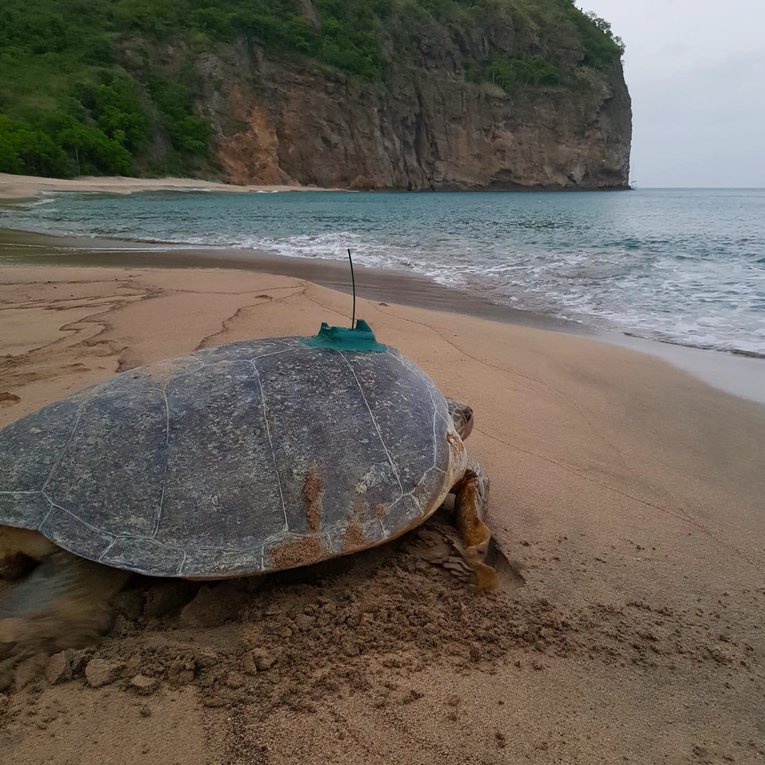
Follow Montserrat's tagged turtles on the move
The Montserrat Marine Turtle Project has successfully tagged 10 female turtles as part of our collaborative conservation project in Montserrat. Now you can track their journey as they begin their migration.
The UK Overseas Territory of Montserrat is an important nesting site for marine turtles in the Caribbean region – yet little is known about their numbers or where they go when they migrate.
We've been working with the Government of Montserrat and the University of Exeter to develop a Marine Turtle Action Plan for Montserrat to ensure evidence-based decisions are made about turtle conservation.

A green turtle returns to sea with a satellite tag after nesting on a Montserrat beach
Credit: Jack Wiggins/UoE
What does the project involve?
The Montserrat Marine Turtle Project will gather biological data, including nesting beach surveys and satellite tracking of the breeding female turtles.
We'll also be using our tried-and-tested Community Voice Method to record the thoughts, opinion, values and knowledge of local people to factor into the plan.
Engaging with communities is vital for the recovery and management of marine turtle populations. Find out more about our turtle conservation work in Montserrat.

Beach patroller Gerrard with Montserrat project lead Alwyn Ponteen and local turtle expert John Jeffers with a satellite tagged green turtle.
Credit: Jack Wiggins/UoE
A long journey
Marine turtles migrate seasonally between their temperate feeding grounds and tropical nesting grounds. Suzie, one of our tagged green turtles in Turks and Caicos Islands, travelled a record-breaking 6000km across the Caribbean over the course of nine months.
Once a marine turtle hatches and heads into the ocean, it rarely returns to land. Green turtles stay in shallow waters until the breeding season. When the females are ready to nest, they travel back to the beach where they were born.
By tracking Montserrat's turtles we hope to learn more about where they go and understand regionally what needs to be done to conserve them.
Follow their progress
So far, the project team has satellite-tagged 10 nesting female turtles (nine green turtles and one hawksbill) as they are about to start their migrations.
We're excited to see the turtles are already on the move – you can track them here on our interactive map.
If you want to find out more about how satellite tracking works you can visit the University of Exeter blog to understand more.

The live map is updated at least daily (click link above). The different coloured lines represent the tracks of the 10 individual turtles we have tagged. The map is showing the most and least accurate tracking fixes, with some suggesting the turtles are inland. Please ignore those inaccurate positions, these female turtles are in the sea unless they come up on the beaches to nest.
UPDATE 19th November 2021
So far eight of our lovely ladies have migrated away from Montserrat at the end of the nesting season, with two staying put there weeks after laying their last clutch off eggs. In fact most of these turtles haven't gone too far at all, with another 4 settling at nearby Antigua and Barbuda, and the only hawksbill we tagged settling at neighbouring Guadeloupe. The furthest distance migrated by one of our tagged turtles is Kathy Ann, who this week completed a 900 km migration to the Dominican Republic - which is pretty impressive. So, we think the final results are in, with the turtles settling at foraging grounds as follows.... Vernaire (yellow track) and Josie (orange) resident in Monserrat; Laynakiki (pink) and Stephanie (light blue) settled off Antigua; Alyssa (dark blue) and Carol (purple track) settled off Barbuda; hawksbill turtle Ellia (lime green) settled off Guadeloupe; Isla (blue track) settled off St Croix in the US Virgin Islands; Aamor (pale green) settled off southern Puerto Rico; Kathy Ann (red track) settled off the Dominican Republic. But the story is not yet over - these tags could transmit for months to come. We know that turtle fishing still occurs in some of these islands, whether it is legal or not - so are our girls safe in the places they call home?? We hope so, but.....
Watch this space to find out!

Turtle conservation team, Montserrat
Credit: Peter Richardson
The project is funded by the UK Government’s Darwin Plus initiative, which provides vital funding to support projects aiming to protect the natural environment of the UKOT’s.







